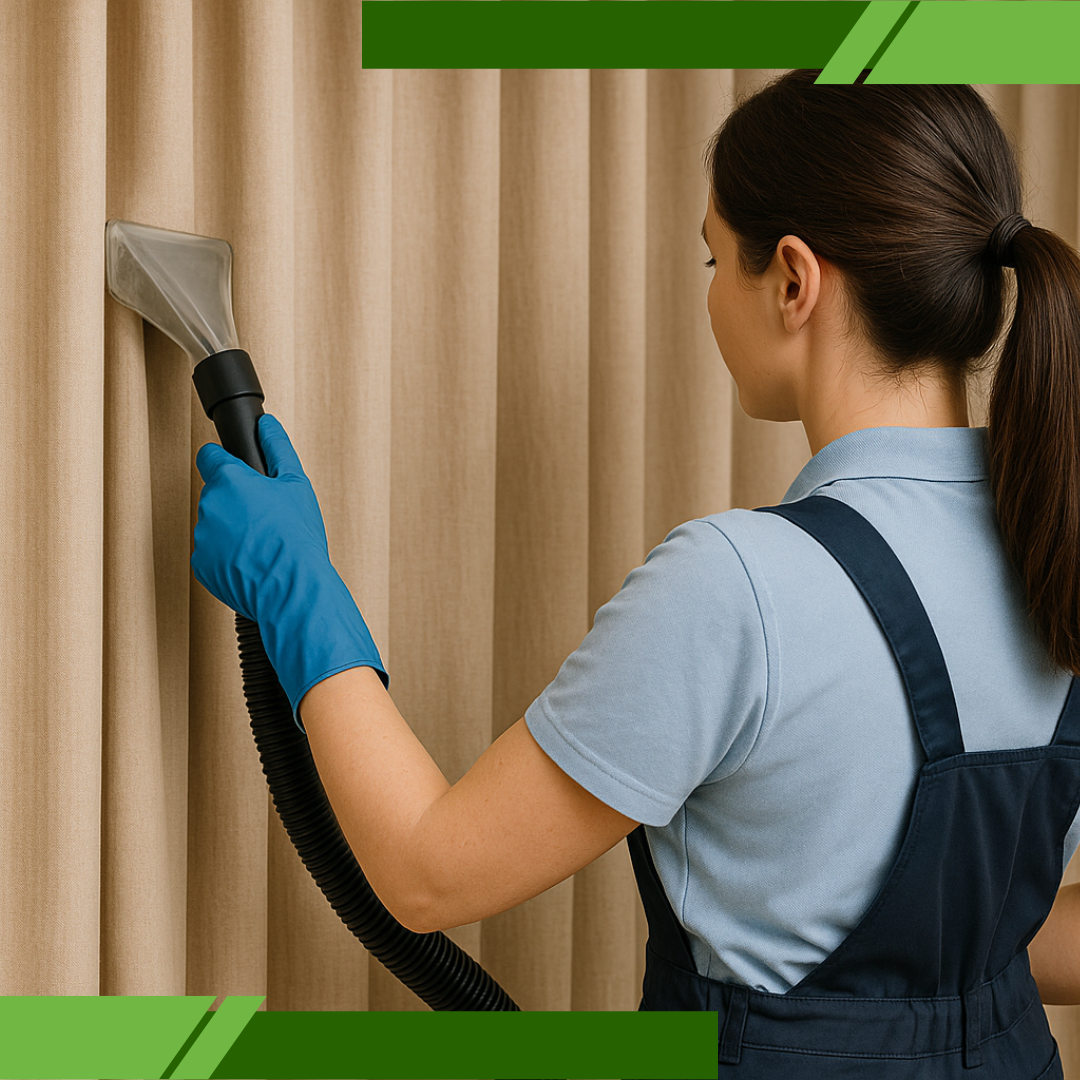Get in touch
Fill this up to proceed

We are committed to providing a world-class carpet, rug, upholstery, drapery or mattress cleaning services that will open your door to a happier and healthier green indoor environment.
Curtains can be the smile of a room—they soften sunlight, frame your windows, and express your personality. But when a stubborn stain appears—from spaghetti sauce to ink spills—it feels like that smile fades instantly. Many people react quickly, scrubbing hard in hopes to remove curtain stains. Unfortunately, that method often causes more harm than good. Curtains aren’t like regular fabrics—they demand special attention because of their delicate construction and diverse materials.
Before reaching for soap or stain remover, always check the care label sewn into the curtain. Think of it as a manual that tells you exactly how to remove curtain stains without ruining the fabric. Whether it’s cotton, linen, polyester, or silk, each material responds differently. Silk may shrink or lose its sheen if handled incorrectly. If the label is missing, err on the side of caution—use the gentlest method first to safely remove curtain stains.
High-end materials like velvet or embroidered linen require even more careful handling. If you’re uncertain, it’s wise to trust professionals specializing in Drapery Cleaning Venice, where trained experts use tailored techniques. Their services are especially helpful when DIY efforts fail to remove curtain stains without risk.
Understanding your fabric is key—it empowers you to confidently and correctly remove curtain stains, preserving the elegance and integrity of your home décor.

Food & Grease Stains –Start by scraping off excess food. Sprinkle baking soda or cornstarch on the greasy spot to absorb oil. Let sit for 15 minutes, then vacuum or shake gently. Mix mild dish soap with warm water and dab (never rub) using a soft white cloth. Blot from the edges inward. This method will remove curtain stains gently.
Ink & Marker- If a pen leaks or your child channels Picasso on your drapes, blot the ink immediately. Apply rubbing alcohol using a cotton ball, placing a paper towel behind the fabric to absorb the transfer. Repeat until the stain fades, then rinse with cool water.
Mud & Dirt- Let mud dry completely—don’t rush it. Brush off the chunks, then use a vacuum. Clean the residue using a detergent-and-water mix. Dab gently and let air dry. Never scrub, as this could fray the fabric.
For residents near the coast, services like Drapery Cleaning Venice are perfect for stubborn saltwater or humidity-induced grime that resists household cleaning.
Wine & Juice- Blot immediately, then apply a vinegar-and-water solution (1:2 ratio). If needed, add a pinch of baking soda. Rinse with cold water. Acting fast is key to removing curtain stains without permanent damage.

Curtains often fall victim to unexpected messes, from pet accidents to spilled coffee. Here’s how to tackle them safely.
Pet Stains & Odors- Use paper towels to blot messes quickly. Apply an enzyme-based cleaner and let it sit for 15 minutes. Blot with a damp cloth. These enzymes neutralize odors and remove curtain stains at the root.
Crayon & Marker Art- If your little artist decorates your drapes, scrape off excess crayon with a dull knife. Place paper towels behind the fabric, dab with rubbing alcohol, and—if wax remains—sandwich the fabric between paper towels and press lightly with a warm iron (test the fabric first).
Blood Stains- Act fast with cold water. Dab the area, then apply 3% hydrogen peroxide on light-colored curtains. Let it fizz and lift the stain gently.
Coffee & Tea- Blot immediately. Use a vinegar-water solution to treat the area. For light curtains, a drop of hydrogen peroxide can help. Let it dry naturally.
Makeup & Lotion- Gently scrape off excess product. Apply baking soda, followed by dish soap diluted in water. Rinse with a damp cloth. These techniques help remove curtain stains while protecting fabric integrity.
If any of these methods seem risky due to delicate materials, calling a professional cleaner is the smartest route.
Avoiding stains in the first place saves time, money, and effort. Consider adopting these smart habits:
Knowing your fabric type can also guide you toward safer cleaning:
Still unsure about your fabric or have a particularly stubborn stain? That’s when calling in professional drapery cleaning services is essential. These experts not only remove curtain stains but also preserve texture, color, and fabric structure using tailored tools and products.
Curtains do more than block light—they enhance warmth, style, and comfort. Protect them with care, gentle methods, and trusted professionals. With the right approach, you can keep your drapes spotless and your living space radiant.
To remove a curtain stain safely, always start by checking the fabric’s care label. Use gentle cleaners like diluted dish soap, vinegar, or rubbing alcohol depending on the stain type. Always blot—never scrub—and test any cleaning solution on a small hidden area first. For delicate materials like silk or velvet, it’s best to contact a professional cleaning service.
Blot the stain immediately using a clean white cloth. Sprinkle baking soda or cornstarch to absorb the grease, let it sit for 15 minutes, and then gently brush or vacuum it off. Use a mild dish soap solution to dab the area, then let it air dry. Avoid using hot water or heat as it can lock in the stain.
It depends on the fabric. Cotton and polyester curtains are generally machine-washable using a gentle cycle with cold or lukewarm water. However, silk, velvet, and linen may require hand washing or professional dry cleaning. Always follow the care instructions and avoid aggressive spin cycles or harsh detergents.
If a stain remains after multiple gentle attempts, do not continue scrubbing—it can damage the fibers. Instead, consult professional drapery cleaners who have the tools and knowledge to safely remove stubborn stains. Green Carpet’s Cleaning offers reliable services for this kind of issue.
Simple daily habits help! Keep food and drinks away from windows, clean up spills right away, vacuum or dust curtains regularly, and keep pets away from drapes when possible. Scheduling a deep clean every 6–12 months with professionals like Green Carpet’s Cleaning can also extend your curtains’ lifespan.

We are committed to providing a world-class carpet, rug, upholstery, drapery or mattress cleaning services that will open your door to a happier and healthier green indoor environment.
We are committed to providing a world-class carpet, rug, upholstery, drapery or mattress cleaning services that will open your door to a happier and healthier green indoor environment.